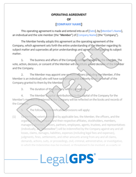Transactional Agreements: Comprehensive Guides & Templates for Your Business
 Chris Daming, J.D., LL.M. : Oct. 10, 2024
Chris Daming, J.D., LL.M. : Oct. 10, 2024
Navigating the complex world of business transactions doesn't have to be overwhelming. Whether you're purchasing real estate, acquiring assets, or modifying existing contracts, having the right transactional agreements in place is crucial to protect your interests and ensure that all parties are aligned. This ultimate guide provides you with expert insights and customizable templates to help you close deals with confidence.


Legal GPS Pro
Protect your business with our complete legal subscription service, designed by top startup attorneys.
- ✅ Complete Legal Toolkit
- ✅ 100+ Editable Contracts
- ✅ Affordable Legal Guidance
- ✅ Custom Legal Status Report
Why Transactional Agreements Matter
Transactional agreements are the backbone of any business deal. They lay out the terms and conditions, define the rights and obligations of each party, and provide legal safeguards to prevent disputes. Here's why they are essential:
Legal Protection
Transactional agreements protect your business by ensuring all parties are legally bound to the agreed terms. Without these agreements, parties are exposed to the risk of breaches or misunderstandings, which could lead to costly disputes and potential lawsuits. For example, not having a proper asset purchase agreement could result in losing valuable assets or financial investment if the other party fails to comply with the agreed terms.
Clarity and Transparency
Clear agreements reduce misunderstandings by outlining expectations for each party. A well-drafted real estate purchase agreement, for instance, specifies the property details, price, and terms of payment, ensuring all parties are on the same page. Transparency in business transactions reduces the likelihood of disputes and contributes to smooth operations.
Risk Mitigation
Identifying potential issues before they arise is crucial in any transaction. Transactional agreements help you address these risks proactively. For example, using a noncompetition agreement in an asset purchase can mitigate the risk of a seller competing against you after the deal closes, protecting your investment.
Efficiency in Business Transactions
Having standardized transactional agreements in place can streamline the process of closing deals. Rather than starting from scratch every time, using our customizable templates can save you valuable time and reduce legal costs. Templates for letters of intent or escrow agreements can help speed up the initial stages of negotiation, allowing you to focus on executing your business strategy.
Expert Guides and Templates for Transactional Agreements
To help you master the art of transactional agreements, we've curated a series of comprehensive guides, each paired with a professional, customizable template. Each section offers practical insights and the tools you need to implement them effectively.
1. Real Estate Purchase Agreements
Importance of Real Estate Purchase Agreements
Real estate purchase agreements are vital in facilitating smooth property transactions. They detail every aspect of the deal, including the property description, price, contingencies, and closing terms. Without such an agreement, buyers and sellers risk miscommunication and potential conflicts that could derail the transaction.
Key Elements to Include in the Agreement
When drafting a real estate purchase agreement, it is essential to include:
-
Property Description: Ensure the property is described accurately to avoid confusion.
-
Purchase Price: Clearly state the agreed price and terms of payment.
-
Contingencies: Include any conditions that must be met for the sale to proceed, such as financing or property inspections.
-
Closing Date: Specify the timeline for closing the deal and transferring ownership.
Step-by-Step Guide to Drafting the Agreement
-
Identify the Parties Involved: Clearly state the names and addresses of the buyer(s) and seller(s).
-
Describe the Property: Include the address, legal description, and any relevant details.
-
Outline the Purchase Price and Payment Terms: Specify how and when the payment will be made.
-
Add Contingencies: Include clauses for financing, inspections, and any other conditions that must be satisfied.
-
Detail the Closing Process: Provide a clear timeline for closing and outline what will happen at each stage.
Resources
- Template: Real Estate Purchase Agreement
- Guide: Real Estate Purchase Agreements: A Master Guide for Friendly Deals
Example Scenarios
Consider a scenario where a property buyer finds undisclosed issues after closing the deal. By including thorough inspection contingencies in the real estate purchase agreement, the buyer can either negotiate repairs or withdraw without financial penalty.


Legal GPS Pro
Protect your business with our complete legal subscription service, designed by top startup attorneys.
- ✅ Complete Legal Toolkit
- ✅ 100+ Editable Contracts
- ✅ Affordable Legal Guidance
- ✅ Custom Legal Status Report
2. Buyer Bring-Down Certificates
Definition and Use Cases
A Buyer Bring-Down Certificate is a document used during the closing of a transaction to confirm that all representations and warranties made by the buyer at the signing are still true at the time of closing. This certificate is essential for ensuring transparency and accountability in business transactions.
Importance in Closing Procedures
Bring-down certificates help mitigate risks by providing a legal confirmation that the buyer's financial and operational state remains unchanged. This reassures the seller that there are no unexpected liabilities or issues that could affect the deal.
Step-by-Step Guide to Creating a Bring-Down Certificate
-
Review Representations and Warranties: Identify all representations made by the buyer that need to be reaffirmed.
-
Draft the Certificate: Use clear language to confirm the accuracy of each representation as of the closing date.
-
Include Necessary Signatures: Ensure that the certificate is signed by an authorized representative of the buyer.
Resources
- Template: Buyer Bring-Down Certificate
- Guide: Buyer Bring-Down Certificates Explained: A Comprehensive Guide
3. Asset Purchase Agreements with Multiple Owners
Complexities of Multi-Owner Deals
Asset Purchase Agreements with Multiple Owners can be challenging due to the need to balance the interests of multiple stakeholders. Each owner may have different priorities, and the agreement must address these to ensure a smooth transaction.
Key Considerations in Asset Purchase Agreements
-
Ownership Interests: Clearly outline the ownership stakes of each party involved.
-
Consent Requirements: Specify the conditions under which owners must provide consent for the sale.
-
Allocation of Purchase Price: Detail how the purchase price will be divided among the owners.
Resources
- Template: Asset Purchase Agreement with Multiple Owners
- Guide: Asset Purchase Agreements with Multiple Owners: A Guide
Example Scenario
Imagine a scenario where multiple owners are selling an asset, and one owner disagrees with the terms at the last minute. By including a well-drafted consent requirement clause, you can ensure that all owners are legally bound to the agreed terms, preventing last-minute disputes from derailing the deal.
4. Noncompetition Agreements in Asset Purchases
Role of Noncompetition Agreements in Asset Purchases
Noncompetition Agreements play a crucial role in protecting your investment after an asset purchase. These agreements prevent the seller from engaging in a similar business that could compete with your newly acquired assets. By including a noncompetition clause, you can safeguard the value of your purchase and prevent potential conflicts.
Protecting Investments Post-Transaction
After purchasing assets, it is vital to ensure that the seller does not start a competing business, which could diminish the value of your acquisition. Noncompetition agreements help mitigate this risk by legally restricting the seller's activities for a specified period and within a defined geographical area.
Drafting Noncompetition Clauses
-
Define the Scope of Restrictions: Clearly state the type of business activities that are restricted.
-
Specify the Duration: Determine how long the noncompetition agreement will be in effect.
-
Outline the Geographical Area: Specify where the restrictions apply to prevent unfair competition.
Resources
- Template: Noncompetition Agreement in Asset Purchases
- Guide: Why Noncompetition Agreements Strengthen Asset Purchases
Example: Adding Business-Specific Restrictions
Consider a scenario where you acquire a local retail business, and the seller plans to open a similar store in the same area. By using our template to include a geographical restriction, you can prevent the seller from opening a competing store within a set radius, protecting your customer base.
5. Escrow Agreements and Earnest Money Deposits
Importance of Escrow in Securing Deals
Escrow Agreements are used to protect both parties during the negotiation phase by ensuring that funds or assets are held by a neutral third party until all conditions of the transaction are met. This approach provides security for both the buyer and seller, minimizing the risk of default.
Step-by-Step Guide on Escrow Agreements
-
Identify the Escrow Agent: Choose a neutral third party to hold the funds or assets.
-
Outline the Terms and Conditions: Clearly state the conditions that must be met before the assets or funds are released.
-
Specify the Responsibilities of Each Party: Detail what each party must do to fulfill their obligations under the agreement.
Resources
Scenarios When Escrow Is Particularly Useful
Escrow agreements are especially useful in real estate transactions, where large sums of money are involved, and both parties need reassurance that the other will meet their obligations. By using an escrow agreement, you can ensure that neither party faces undue risk during the closing process.
6. Mutual Rescission and Release Agreements
Understanding Contract Termination
Mutual Rescission and Release Agreements allow parties to terminate a contract amicably and legally. These agreements are often used when both parties mutually decide to end their obligations without any penalties or further liabilities.
Legal Considerations for Rescission
When drafting a mutual rescission and release agreement, it is important to:
-
Clearly Identify the Parties: Ensure all involved parties are properly identified.
-
Specify the Original Contract: Reference the original contract being terminated.
-
Detail the Terms of Rescission: Clearly outline the rights and obligations of each party upon termination.
Resources
- Template: Mutual Rescission and Release Agreement
- Guide: Mutual Rescission and Release Agreements: Complete Guide
Practical Application: Avoiding Legal Disputes
Consider a scenario where two businesses decide to end a partnership without any lingering obligations. Using a mutual rescission and release agreement ensures that both parties are released from the original contract, preventing future disputes.


Legal GPS Pro
Protect your business with our complete legal subscription service, designed by top startup attorneys.
- ✅ Complete Legal Toolkit
- ✅ 100+ Editable Contracts
- ✅ Affordable Legal Guidance
- ✅ Custom Legal Status Report
7. Stock Purchase Noncompetition Agreements
Ensuring Fair Competition Post-Stock Purchase
Stock Purchase Noncompetition Agreements are used to protect the buyer's interests when acquiring shares in a company. By restricting the seller's ability to compete, these agreements ensure that the buyer's newly acquired investment is not undermined by competitive activities.
Key Elements in Noncompetition Clauses for Stock Purchases
-
Define Restricted Activities: Clearly specify what types of activities are restricted.
-
Set a Time Frame: Determine how long the noncompetition clause will be in effect.
-
Establish Geographic Limitations: Outline the geographic scope of the noncompetition clause.
Resources
- Template: Stock Purchase Noncompetition Agreement
- Guide: Stock Purchase Noncompetition Agreements: In-Depth Guide
Example Scenario
Imagine purchasing shares in a local manufacturing company, and the seller plans to start a competing business. By including a noncompetition agreement, you can prevent the seller from establishing a similar company in the same region, protecting your investment.
8. Amendments to Purchase Agreements
Why Amendments Are Needed
Amendments to Purchase Agreements are used to modify the terms of an existing contract to reflect new circumstances or agreements between the parties. Amendments can be essential to ensure that the original agreement stays relevant and accurate.
When to Use an Amendment
Amendments are typically used when:
-
Changes in Payment Terms: The buyer and seller agree to adjust the payment schedule.
-
Changes in Delivery Dates: The timeline for delivery needs to be updated.
-
New Conditions or Contingencies: Additional conditions need to be added to the agreement.
Resources
- Template: Amendment to Purchase Agreement
- Guide: Protect Deals with Amendments to Purchase Agreements
Real-World Application
Consider a scenario where the buyer requests an extension of the delivery date for certain assets. By using an amendment, both parties can agree to a new delivery timeline without drafting an entirely new contract.
9. Letters of Intent in Business Transactions
Role of Letters of Intent
Letters of Intent (LOI) are used in the initial stages of a business transaction to outline the key terms and intentions of the parties. An LOI sets the foundation for further negotiations and can help ensure that both parties are aligned before drafting a formal agreement.
How to Write an Effective LOI
-
Outline Key Terms: Include key terms such as price, responsibilities, and timeline.
-
State the Intentions: Clearly specify the intent of both parties without creating a binding agreement.
-
Include a Confidentiality Clause: Protect sensitive information exchanged during negotiations.
Resources
- Template: Letter of Intent
- Guide: Writing an Effective Letter of Intent: Ultimate Guide
Example: Setting the Stage for Negotiations
Imagine entering negotiations to acquire a competitor's business. By using an LOI, you can outline the proposed purchase terms and clarify both parties' intentions before committing to a binding agreement.
10. Assignment and Assumption Agreements
Role of Assignment and Assumption Agreements
Assignment and Assumption Agreements are used to transfer contractual rights and obligations from one party to another. These agreements are crucial when a party wants to transfer its role in a contract, such as assigning lease rights or transferring ownership of assets.
Key Elements to Include in the Agreement
-
Identify the Assignor and Assignee: Clearly specify the parties involved in the transfer.
-
Outline the Transferred Rights and Obligations: Define what rights and obligations are being assigned.
-
Consent Requirements: Ensure that the consent of the original contract party is obtained if required.
Resources
- Template: Assignment and Assumption Agreement
- Guide: Assignment and Assumption Agreements: Comprehensive Guide
Example Scenario: Transferring Lease Rights
Consider a scenario where a business wants to assign its lease rights to a new owner. By using an assignment and assumption agreement, the original tenant can transfer its rights and obligations to the new tenant, ensuring continuity of the lease and protecting both parties.
11. Withdrawal Agreements
Handling Partner or Member Withdrawals
Withdrawal Agreements are used when a partner or member wants to exit a partnership or an LLC. This process must be managed carefully to ensure that the withdrawing party's rights are respected, and the remaining members' interests are protected.
Key Elements of Withdrawal Agreements
-
Identify the Withdrawing Party: Clearly specify the partner or member who is withdrawing from the business.
-
Outline the Terms of Withdrawal: Include details such as the withdrawal date, payment terms for any equity, and how responsibilities will be handled.
-
Valuation of Interest: Determine how the withdrawing party's interest in the business will be valued and what method will be used to calculate their share.
-
Obligations and Liabilities: Specify any ongoing obligations or liabilities that the withdrawing member may still have, even after their departure.
Resources
- Template: Withdrawal Agreement
- Guide: Withdrawal Agreements Explained: Essential Guide
Example Scenario: Managing a Partner's Exit
Imagine a scenario where one of the partners in a consulting firm wants to leave the business. A withdrawal agreement can be used to outline the financial settlement, transfer of responsibilities, and any restrictions on future competition, ensuring a smooth transition for both the departing and remaining partners.
12. Name Affidavits
Purpose of Name Affidavits
Name Affidavits are used to verify the identity of an individual involved in a business transaction, especially when there may be variations in how their name appears on different documents. This helps prevent fraud and ensures consistency in legal paperwork.
Key Elements to Include
-
Full Legal Name: Include the individual's full legal name as it appears on official documents.
-
Aliases or Variations: List any known aliases, nicknames, or variations of the individual's name.
-
Purpose of the Affidavit: Clearly state why the name affidavit is being used, such as to verify identity in a real estate transaction.
Resources
- Template: Name Affidavit
- Guide: Name Affidavits: What You Need to Know
Example Scenario: Identity Verification in Real Estate
Consider a situation where an individual is purchasing a property, but their name appears slightly differently on different identification documents. A name affidavit can be used to confirm that all variations refer to the same person, ensuring a smooth and legally compliant transaction.


Legal GPS Pro
Protect your business with our complete legal subscription service, designed by top startup attorneys.
- ✅ Complete Legal Toolkit
- ✅ 100+ Editable Contracts
- ✅ Affordable Legal Guidance
- ✅ Custom Legal Status Report
13. Assumption Agreements
Understanding Assumption Agreements
Assumption Agreements are used when one party agrees to take over the obligations of another party in an existing contract. This type of agreement is commonly used in loan transfers or lease takeovers, where the new party "assumes" the responsibilities originally held by the other.
Key Elements to Include
-
Identify the Parties: Clearly specify the original party, the assuming party, and any third parties involved.
-
Outline Assumed Obligations: Detail the obligations being assumed, such as payments, duties, or responsibilities under the original contract.
-
Obtain Consent: Ensure that the third party to the original agreement consents to the assumption.
Resources
- Template: Assumption Agreement
- Guide: Assumption Agreements Simplified: A Quick Guide
Example Scenario: Taking Over a Lease
Imagine a scenario where a business owner wants to sell their retail store, including the lease for the commercial space. An assumption agreement can be used to transfer the lease obligations to the new owner, ensuring the landlord, the current tenant, and the new tenant are all in agreement.
14. Contract Addendums
Role of Contract Addendums
Contract Addendums are used to add new terms or conditions to an existing contract without altering the original document. Addendums are particularly useful when circumstances change, and both parties agree to modify the terms of their agreement.
When to Use an Addendum
-
Additional Terms: Use an addendum to add new terms that were not included in the original contract.
-
Clarifications: Clarify ambiguous terms or conditions in the original contract.
-
Price Adjustments: Modify the payment terms or adjust the price due to changes in scope or other factors.
Resources
- Template: Contract Addendum
- Guide: Contract Addendums: Essential Knowledge for Success
Example Scenario: Adding Services to an Existing Contract
Imagine a scenario where a client requests additional services not included in the original contract. A contract addendum can be used to outline the new services, associated costs, and any changes in delivery timelines, ensuring both parties are aligned on the updated scope of work.
15. Affidavits of Ownership
Purpose of Affidavits of Ownership
Affidavits of Ownership are used to confirm that an individual or entity owns a specific property or asset. These affidavits are often required in real estate transactions or when transferring ownership of a business.
Key Elements to Include
-
Identify the Owner: Clearly specify the individual or entity that owns the property or asset.
-
Describe the Property: Provide a detailed description of the property or asset being claimed, including any identifying information.
-
Purpose of the Affidavit: State the purpose for which the affidavit is being used, such as confirming ownership in a sale or transfer.
Resources
Example Scenario: Confirming Property Ownership
Consider a situation where an individual is selling a piece of land, and the buyer requires proof of ownership. An affidavit of ownership can be used to confirm that the seller is the rightful owner, helping to facilitate a smooth transaction.
Common Challenges in Drafting Transactional Agreements
Drafting transactional agreements can be challenging due to the need to balance legal precision with practical clarity. Below are some common challenges that businesses face when drafting these agreements and how to address them effectively.
1. Balancing Legal Language with Readability
One of the biggest challenges in drafting transactional agreements is balancing the need for legal accuracy with readability. Legal documents must be precise to avoid ambiguity, but overly complex language can make agreements difficult for non-lawyers to understand.
How to Address This Challenge
-
Use Plain Language Where Possible: Aim for clarity by using plain language while retaining the necessary legal terms.
-
Provide Definitions: Include a section that defines any technical or legal terms to ensure all parties understand the content.
-
Break Down Complex Clauses: Use bullet points or sub-clauses to break down complex provisions into more digestible parts.
2. Ensuring Completeness and Avoiding Omissions
Transactional agreements need to be comprehensive to avoid disputes arising from omitted terms. Missing a critical clause, such as a dispute resolution mechanism, can lead to costly and time-consuming conflicts.
How to Address This Challenge
-
Use Checklists: Develop a checklist of key clauses that should be included in the agreement to ensure completeness.
-
Consult with Legal Experts: Involve legal professionals to review the agreement and identify any missing elements.
-
Standardize Templates: Use standardized templates that include all essential clauses, reducing the risk of omissions.
3. Aligning the Interests of Multiple Parties
In agreements involving multiple parties, such as asset purchase agreements with multiple owners, it can be challenging to align the interests of all stakeholders. Disagreements can arise over terms like price allocation, responsibilities, or exit conditions.
How to Address This Challenge
-
Facilitate Open Communication: Engage all parties in discussions early in the drafting process to understand their interests.
-
Include Dispute Resolution Clauses: Draft dispute resolution clauses to provide a clear path for resolving disagreements if they arise.
-
Use Neutral Language: Draft clauses in a way that is fair and balanced to all parties involved.
4. Keeping Up with Regulatory Changes
Laws and regulations that impact transactional agreements can change frequently. Keeping agreements compliant with the latest legal requirements is crucial to avoid invalidating key terms.
How to Address This Challenge
-
Regular Legal Reviews: Schedule regular reviews of your agreements to ensure they comply with the most current regulations.
-
Stay Informed: Keep up with industry news and legal updates that may impact your agreements.
-
Use Professional Legal Services: Consult with legal professionals who specialize in transactional law to ensure compliance.
5. Drafting Enforceable Non-Compete Clauses
Non-compete clauses can be difficult to enforce, particularly if they are too broad in scope, duration, or geography. Courts may strike down non-compete clauses that are seen as overly restrictive.
How to Address This Challenge
-
Narrow the Scope: Ensure that the non-compete clause is reasonable in terms of geographic scope and duration.
-
Justify the Restrictions: Be prepared to justify why the restrictions are necessary to protect your business interests.
-
Consult Local Laws: Non-compete enforceability varies by jurisdiction, so ensure that the clause complies with local laws.
Final Thoughts on Transactional Agreements
Having well-drafted transactional agreements is crucial for protecting your business interests and ensuring smooth operations. Whether you're purchasing real estate, modifying a contract, or entering into a partnership, a clear and comprehensive agreement can prevent misunderstandings and legal disputes.
Do I need a business lawyer?
The biggest question now is, "Do I need a business lawyer?" For most businesses and in most cases, you don't need a lawyer to start your business. Instead, many business owners rely on Legal GPS Pro to help with legal issues. Legal GPS Pro is your All-in-One Legal Toolkit for Businesses.
Developed by top startup attorneys, Pro gives you access to 100+ expertly crafted templates including operating agreements, NDAs, and service agreements, and an interactive platform. All designed to protect your company and set it up for lasting success.

Legal GPS Pro
Protect your business with our complete legal subscription service, designed by top startup attorneys.
- ✅ Complete Legal Toolkit
- ✅ 100+ Editable Contracts
- ✅ Affordable Legal Guidance
- ✅ Custom Legal Status Report

Legal GPS Pro: All-in-One Legal Toolkit
100+ legal templates, guides, and expert advice to protect your business.
Trusted by 1000+ businesses
